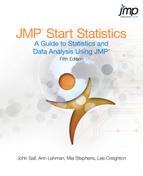 The Difference Between Two Means
by Lee Creighton, Mia Stephens, Ann Lehman, Ph.D., John Sall
JMP Start Statistics, 5th Edition
The Difference Between Two Means
by Lee Creighton, Mia Stephens, Ann Lehman, Ph.D., John Sall
JMP Start Statistics, 5th Edition
- Preface
- Preliminaries
- JMP Right In
- Data Tables, Reports, and Scripts
- Formula Editor Adventures
- What Are Statistics?
- Simulations
- Univariate Distributions: One Variable, One Sample
- Overview
- Looking at Distributions
- Describing Distributions of Values
- Statistical Inference on the Mean
- Practical Significance vs. Statistical Significance
- Examining for Normality
- Special Topic: Practical Difference
- Special Topic: Simulating the Central Limit Theorem
- Seeing Kernel Density Estimates
- Exercises
- The Difference Between Two Means
- Overview
- Two Independent Groups
- When the Difference Isn’t Significant
- Check the Data
- Launch the Fit Y by X Platform
- Examine the Plot
- Display and Compare the Means
- Inside the Student’s t-Test
- Equal or Unequal Variances?
- One-Sided Version of the Test
- Analysis of Variance and the All-Purpose F-Test
- How Sensitive Is the Test? How Many More Observations Are Needed?
- When the Difference Is Significant
- Normality and Normal Quantile Plots
- Testing Means for Matched Pairs
- Two Extremes of Neglecting the Pairing Situation: A Dramatization
- A Nonparametric Approach
- Exercises
- Comparing Many Means: One-Way Analysis of Variance
- Fitting Curves through Points: Regression
- Categorical Distributions
- Categorical Models
- Overview
- Fitting Categorical Responses to Categorical Factors: Contingency Tables
- Two-Way Tables: Entering Count Data
- If You Have a Perfect Fit
- Special Topic: Correspondence Analysis— Looking at Data with Many Levels
- Continuous Factors with Categorical Responses: Logistic Regression
- Surprise: Simpson's Paradox: Aggregate Data versus Grouped Data
- Generalized Linear Models
- Exercises
- Multiple Regression
- Fitting Linear Models
- Overview
- The General Linear Model
- Kinds of Effects in Linear Models
- Coding Scheme to Fit a One-Way anova as a Linear Model
- Regressor Construction
- Interpretation of Parameters
- Predictions Are the Means
- Parameters and Means
- Analysis of Covariance: Continuous and Categorical Terms in the Same Model
- The Prediction Equation
- The Whole-Model Test and Leverage Plot
- Effect Tests and Leverage Plots
- Least Squares Means
- Lack of Fit
- Separate Slopes: When the Covariate Interacts with a Categorical Effect
- Two-Way Analysis of Variance and Interactions
- Optional Topic: Random Effects and Nested Effects
- Exercises
- Design of Experiments
- Bivariate and Multivariate Relationships
- Exploratory Modeling
- Control Charts and Capability
- Mechanics of Statistics
- Analyze and Graph Menu Commands
- Answers to Selected Exercises
- Chapter 4, "Formula Editor Adventures"
- Chapter 7, "Univariate Distributions: One Variable, One Sample"
- Chapter 8, "The Difference Between Two Means"
- Chapter 9, "Comparing Many Means: One-Way Analysis of Variance"
- Chapter 10, "Fitting Curves through Points: Regression"
- Chapter 11, "Categorical Distributions"
- Chapter 12, "Categorical Models"
- Chapter 13, "Multiple Regression"
- Chapter 14, "Fitting Linear Models"
- Chapter 15, "Design of Experiments"
- Chapter 16, "Bivariate and Multivariate Relationships"
- Chapter 17, "Exploratory Modeling"
- Chapter 18, "Control Charts and Capability"
- References and Data Sources
- Technology License Notices
- Index
8
The Difference Between Two Means
Overview
Are the mean responses from two groups different? What evidence would it take to convince you? This question opens the door to many of the issues that pervade statistical inference, and this chapter explores these issues. Comparing group means also introduces an important statistical distinction regarding how the measurement or sampling process affects the way the resulting data are analyzed. This chapter also talks about validating statistical assumptions.
When two groups are considered, there are two distinct situations that lead to two different analyses:
Independent Groups—the responses from the two groups are unrelated and statistically independent. For example, the two groups might be two classrooms with two sets of students in them. The responses come from different experimental units or subjects. The responses are uncorrelated and the means from the two groups are uncorrelated.
Matched Pairs—the two responses form a pair of measurements coming from the same experimental unit or subject. For example, a matched pair might be a before-and-after blood pressure measurement from the same subject. These responses are correlated, and the statistical method must take that into account.
-
No Comment
..................Content has been hidden....................
You can't read the all page of ebook, please click here login for view all page.